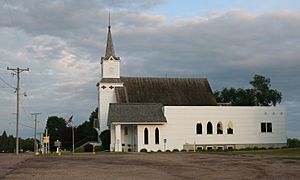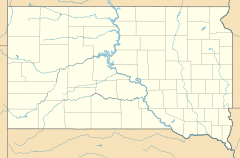Renner, South Dakota facts for kids
Quick facts for kids
Renner
|
|
|---|---|

|
|
| Country | United States |
| State | South Dakota |
| County | Minnehaha |
| Founded | 1898 |
| Named for | Leonard Renner |
| Elevation | 1,434 ft (437 m) |
| Time zone | UTC-6 (Central (CST)) |
| • Summer (DST) | UTC-5 (CDT) |
| ZIP codes |
57055
|
| Area code(s) | 605 |
| FIPS code | 46-54140 |
| GNIS feature ID | 1257356 |
Renner is a small community in Minnehaha County, South Dakota. It is an unincorporated community, which means it doesn't have its own local government like a city or town. Renner has a special ZIP code of 57055.
This community is located just north of Sioux Falls, a larger city. You can find it along South Dakota Highway 115. Renner is also in the valley of the Big Sioux River. A railroad line, now owned by the state of South Dakota, runs through the area.
A very famous event happened in Renner in 1927. Charles Lindbergh, who was the first person to fly alone across the Atlantic Ocean without stopping, visited Renner on August 27, 1927. Many people, estimated to be between thirty and forty thousand, came to Renner to welcome him!
History of Renner
Renner was officially started in 1898. A train station, called a depot, was built here in 1907 along the Milwaukee Railroad line. The community was named after Leonard Renner. He was a local farmer who owned the land where the train depot was built.
Renner was also home to one of the earliest projects to bring electricity to farms in the United States. This happened in 1923, thanks to the Northern States Power Company. This project was a big success for the farmers. However, it was quite expensive for the company, so they didn't do many more rural electrification projects right away.
Renner Lutheran Church
The Renner Lutheran Church is a very old and important building in the community. It was founded in 1868 by immigrants from Norway. Back then, it was known as Nidaros Church.
Many people believe it is the oldest ELCA church in all of South Dakota. The church building is so important that it is listed on the National Register of Historic Places. This means it's recognized as a special historical site.


